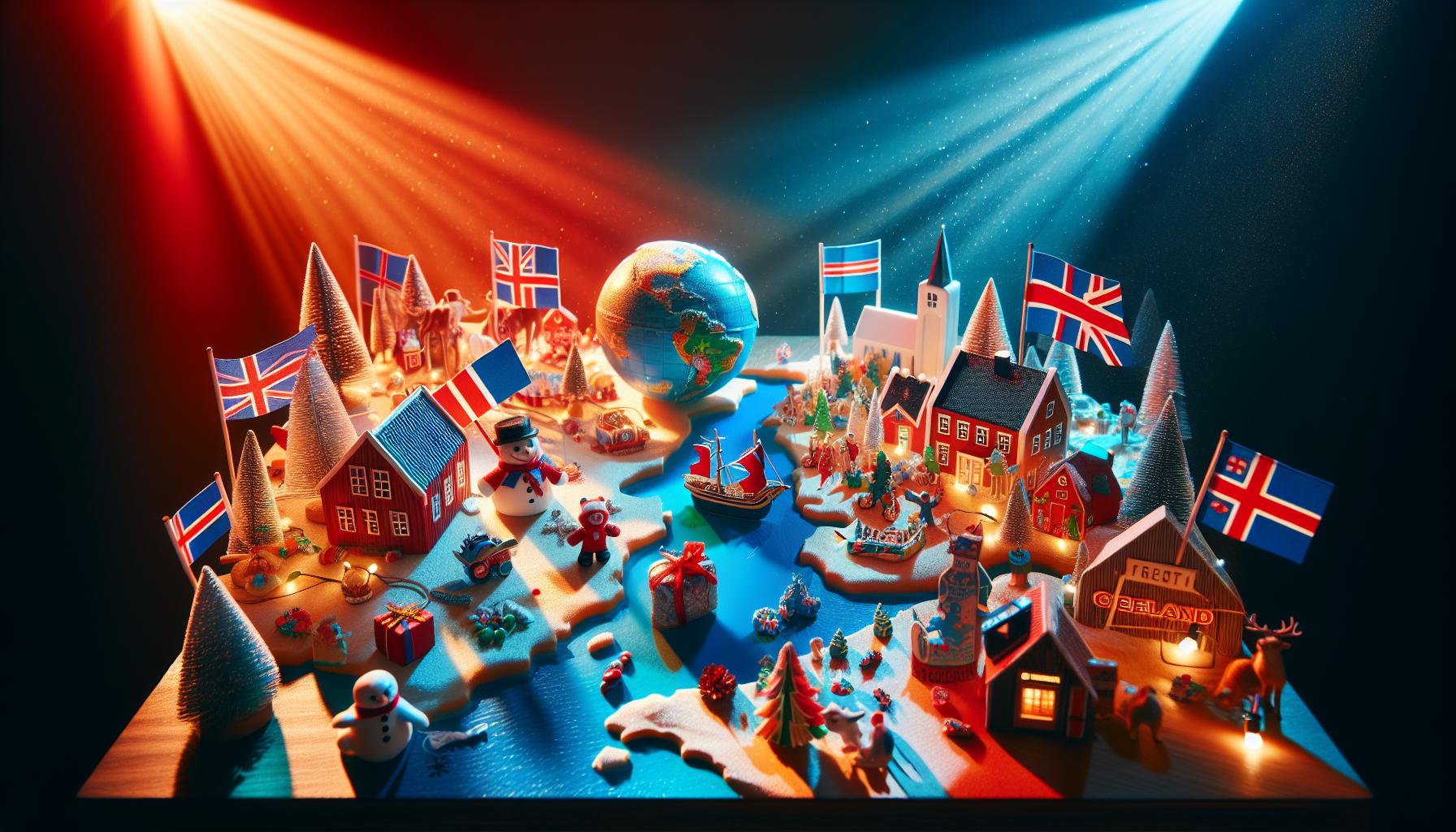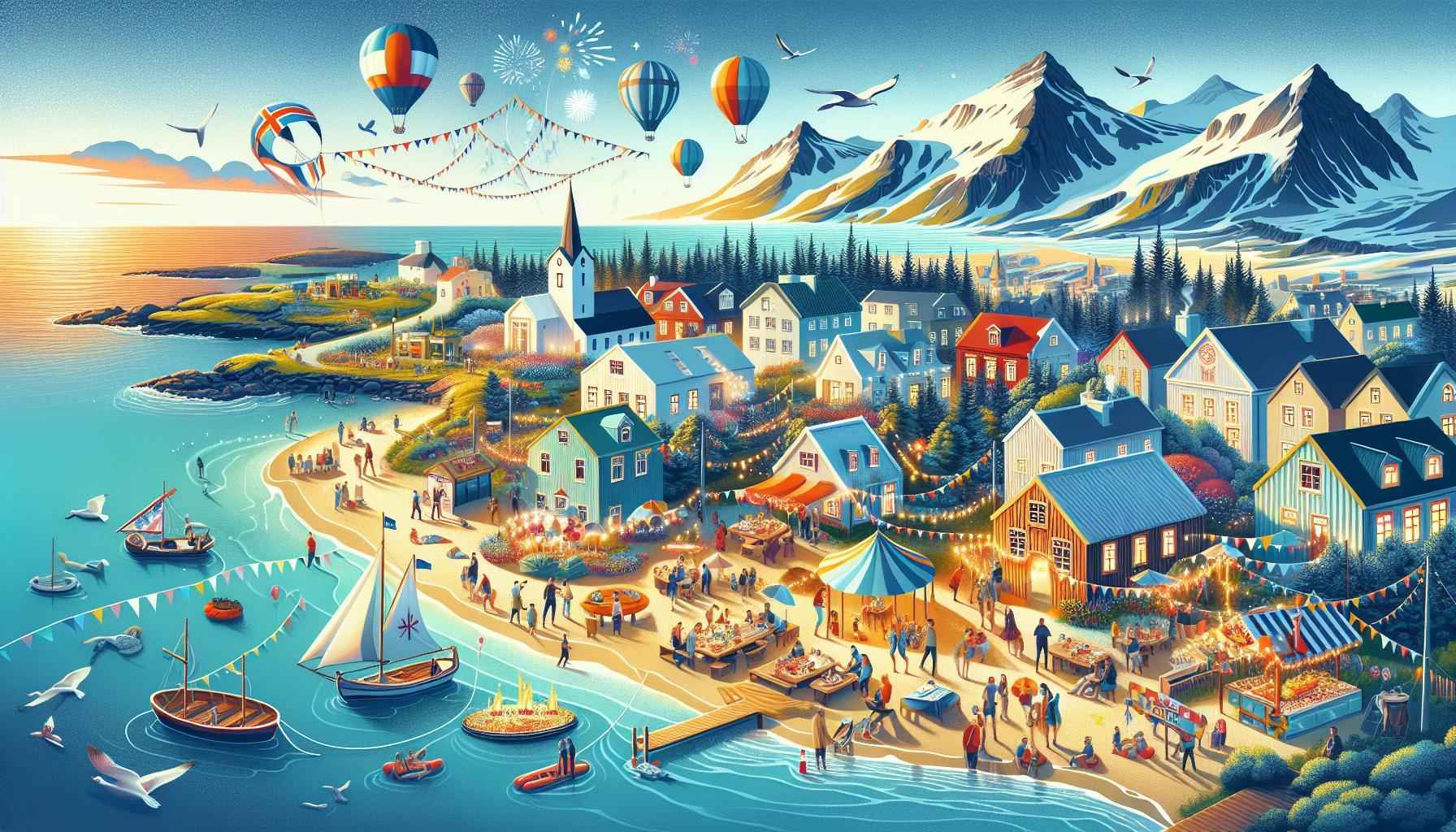On a clear day, can the stunning landscapes of Greenland emerge on the horizon from Iceland’s shores? Many travelers wonder about this possibility, intrigued by the enchanting sight of two northern territories. Exploring the visibility factors and best viewpoints not only enhances your journey but enriches your understanding of these magnificent regions and their unique climates.
Understanding the Geographic Relationship Between Iceland and Greenland

The striking proximity of Iceland and Greenland often sparks curiosity about their geographic relationship and visibility. Sitting just over 300 kilometers apart in the North Atlantic Ocean, both nations are marvels of natural beauty, yet they exhibit distinct environments and cultural identities. While visible on clear days, Greenland may seem deceptively close, yet the journey to experience its otherworldly landscapes requires careful planning and consideration of travel logistics.
Visibility Between Iceland and Greenland
The question of whether you can see Greenland from Iceland is frequently posed by travelers seeking breathtaking views. On clear days, particularly from the northern coast of Iceland, you may catch a glimpse of Greenland’s mountainous terrain and icy peaks. However, factors such as weather conditions, time of day, and atmospheric clarity can significantly affect visibility. Here are a few key points to consider:
- Weather Conditions: The best chance to see Greenland occurs during clear, crisp weather in late spring or summer.
- Location: Optimal viewing spots include the Snæfellsnes Peninsula and northern coastal regions like Siglufjörður.
- Light Conditions: Midday offers the best light for visibility; early mornings or late afternoons may diminish sightlines.
Experiencing the Distance
The journey to Greenland from Iceland often involves scenic flights or boat rides, making the trip itself part of the adventure. Major operators provide regular flights connecting Reykjavík to towns like Nuuk and Ilulissat, revealing panoramic views of the vast ice sheets and rugged coastlines from the air. Despite the visual allure from afar, encountering Greenland up close allows for unique experiences:
| Activity | Location | Highlights |
|---|---|---|
| Dog Sledding | Ilulissat | Ride on a sled through stunning ice fjords. |
| Ice Caving | Disko Bay | Explore breathtaking ice caves and formations. |
| Glacier Hiking | Kangerlussuaq | Walk on the mighty Greenland ice sheet. |
Regardless of visibility, the fascinating contrast between the two landmasses enhances their charm. Iceland is often characterized by its volcanic landscapes and vibrant culture, while Greenland offers a raw, icy wilderness filled with opportunities for exploration and adventure. For travelers captivated by both destinations, incorporating both into your itinerary can yield unforgettable experiences, each revealing its unique allure and beauty.
Ideal Times for Spotting Greenland from Iceland
To catch a glimpse of Greenland from Iceland, timing is everything. The weather and atmospheric conditions play a significant role in visibility, with clearer skies offering the best chances for spotting the distant landmass. The optimal months to attempt this are typically late spring and early summer, particularly from May to early July. During this period, the Icelandic weather stabilizes, leading to fewer cloud formations and increased sunshine, which can dramatically enhance visibility across the water.
Seasonal Considerations
In Iceland, the climate shifts as you move from winter to summer. As the days lengthen and temperatures rise, you’ll find more favorable conditions for viewing distant landscapes. The months of April and May still present opportunities, but snowfall and lingering cold can obscure views. Experienced travelers recommend targeting mid-June to early July, when the weather is generally more hospitable, and daylight hours are prolonged, increasing your chances of making that remarkable sighting.
Best Viewing Locations
The ideal spots for attempting to see Greenland include coastal areas of western Iceland, especially locations near Stykkishólmur and the Snæfellsnes Peninsula. Finding a viewpoint with a clear line of sight toward Disko Bay or the northeastern Greenland coast can markedly improve your chances. These areas tend to have fewer obstructions and offer expansive views over the ocean.
Weather Patterns and Viewing Tips
Visibility can vary significantly based on local weather patterns, such as fog and wind. It’s essential to stay informed about the daily forecasts. Consider utilizing local weather services or apps to check for clear conditions on your intended viewing day. Additionally, sunrise or sunset can enhance visibility, with softer light reducing glare from the water, making the experience even more enchanting.
To maximize your chances of success, try to plan your visit around these factors, and always be prepared for sudden weather changes characteristic of the North Atlantic region. With a little patience and the right timing, the majestic sight of Greenland across the water could become a breathtaking highlight of your Iceland adventure.
Top Locations in Iceland for Unforgettable Views of Greenland

While the stunning landscapes of Iceland are breathtaking on their own, the allure of spotting Greenland adds an extra layer of excitement for travelers. Many visitors often ponder the question: can you actually see Greenland from Iceland? Although Greenland is generally not visible to the naked eye due to geographical distances and weather conditions, certain locations in Iceland provide the best chances for those curious to catch a glimpse of this vast island.
Best Spots for Potential Views
Certain vantage points in Iceland might offer a fleeting glimpse of Greenland under ideal conditions. Here are some popular locations known for their spectacular views:
- Snæfellsnes Peninsula: This location is renowned for its dramatic landscapes featuring mountains and coastlines. From here, on clear days, intrepid observers might just make out the outline of Greenland.
- Westfjords: Areas along the coastline of the Westfjords, particularly from high elevations, can provide stunning vistas. The remote nature of this region often means fewer clouds to obstruct the view.
- Reykjavik’s Esja Mountain: Hiking to the summit of Esja, which stands just outside of the capital, rewards hikers with panoramic vistas of the surrounding ocean and, on exceptionally clear days, the faint silhouette of Greenland.
Factors Influencing Visibility
Viewing conditions play an essential role in determining whether Greenland can be seen from Iceland. Travel enthusiasts should consider the following factors when planning their viewing excursions:
| Factor | Impact on Visibility |
|---|---|
| Weather Conditions | Clear skies provide the best chances for visibility; cloudy skies can completely obscure views. |
| Time of Year | Winter months often bring clearer air but shorter daylight; summer offers longer days and varied visibility. |
| Elevation | Higher altitudes, such as mountain summits, typically provide superior viewpoints for distant sights. |
In planning your journey, ensure you are equipped with patience and perhaps a camera for the stunning landscapes surrounding these view points, even if Greenland remains elusive. The beauty of Iceland itself is a worthy reward, combining natural elements and the thrill of adventure, whether or not the majestic shores of Greenland come into view.
Weather Considerations: How Climate Affects Visibility

There’s more to visibility than meets the eye, particularly when considering how climate conditions shape our scenic experiences in regions like Iceland and Greenland. The clarity of the atmosphere plays a crucial role in whether one can glimpse the stunning vistas of Greenland from the shores of Iceland. Various meteorological factors contribute to visibility, from humidity levels to atmospheric pressure, making understanding these elements essential for both travelers and photographers hoping to capture breathtaking landscapes.
Impact of Weather on Visibility
Visibility can fluctuate significantly based on weather conditions, and certain times of year offer better chances for clear views. Key weather considerations include:
- Fog and Mist: Coastal areas, especially between Iceland and Greenland, can experience fog due to temperature differentials in air. Fog is more prevalent in the summer and can obscure views, making it challenging to see distant landforms.
- Precipitation: Rain or snow can drastically reduce visibility. Stormy weather or precipitation events tend to obscure distant horizons, limiting how far one can see.
- Humidity: High humidity can result in murky air, impacting visibility. Regions with low humidity often provide clearer conditions, ideal for viewing distant landscapes.
Understanding these elements is crucial for anyone asking, “Can you see Greenland from Iceland?” Observers should plan their trips according to local weather forecasts, ideally selecting days when high pressure dominates, bringing clearer skies.
Seasonal Considerations
The time of year can significantly affect visibility. For instance:
| Season | Visibility Conditions |
|---|---|
| Winter | Often provides clear air, but can be subject to snowy conditions that obscure views. |
| Spring | Transition period; variable weather can lead to both good and poor visibility. |
| Summer | More frequent fog and humidity can limit visibility, especially in coastal areas. |
| Fall | Typically offers clearer skies and potentially great views of Greenland. |
Travelers hoping to optimize their experience should consider heading out on crisp, clear days and keep an eye on local forecasts. Understanding how climate affects visibility can enhance your viewing experience, ensuring you seize the opportunity to enjoy the remarkable beauty of the landscapes around Iceland—after all, it’s not just about being in the right location, but also about being there at the right time.
Local Legends and Stories About Greenlandic Sightings

In the landscapes that frame the horizon between Greenland and Iceland, rich threads of legend and folklore intertwine with the natural beauty. The ethereal northern lights, known in Greenlandic as “Arsarnerit,” represent not only breathtaking views but also deeply ingrained stories that connect generations. These lights are believed to be the spirits of ancestors engaging in a playful game of football with a walrus skull—a whimsical yet poignant reminder of the reverence for the past and the stories that shape cultural identity [2[2].
Local tales about the mythical beasts of Greenland often serve as both warnings and guides. Traditionally, these narratives were crafted to provide insights into survival in the harsh Arctic environment, highlighting the intertwined destinies of the people and the nature around them. Creatures such as the “Nuliaqat,” believed to protect against harm, echo through the ages, reminding us how nature was once perceived as an all-encompassing beast that governed life [1[1]. Such stories resonate with those who gaze across the waters, contemplating the vastness between the two lands and reflecting on shared experiences.
As visitors seek to capture the visibility and best views that answer the question, Can You See Greenland from Iceland: Visibility and Best Views, they might find themselves drawn not just to the physical sight but also to the legends swirling around these vistas. Being aware of the stories enhances the experience, transforming a simple view into a living tapestry of culture and history. Engaging with these narratives can offer a deeper appreciation for the sights beyond, reminding us that every horizon holds the whispers of those who came before us—a vital connection across time and space.
Whether you’re standing on the shores of Iceland or looking through a lens, the local legends add a rich layer to your sightseeing experience. Make time to explore these stories and consider how the mystical elements of Icelandic and Greenlandic folklore can deepen your connection to the landscape. For a more immersive experience, you might even explore tours or local guides who specialize in folklore, enriching your visit with tales that have echoed through generations.
Tips from Locals: Best Practices for Sightseeing

To truly appreciate the breathtaking landscapes and unique cultural experiences between Iceland and Greenland, local insights are invaluable. Travelers looking to explore the best vistas and maximize their sightseeing opportunities will find numerous tips that can transform their adventures into unforgettable journeys.
Timing Your Visit
One of the most crucial factors in experiencing optimal visibility is timing. The clarity of views from Iceland to Greenland varies significantly with the seasons. Summer months, particularly June through August, tend to offer the best conditions for visibility, as the weather is milder and the days are longer. Early morning or late evening are often recommended for the best light and less hazy conditions, enhancing your chances of spotting the majestic Greenlandic landscape from Iceland’s shores.
Choosing the Right Location
Several ideal vantage points exist around Iceland for witnessing Greenland’s distant beauty. Locals often suggest the following locations:
- Snæfellsnes Peninsula: Known for its diverse scenery, this area provides panoramic views ideal for spotting Greenland on clear days.
- Reykjavik’s coastline: The capital offers readily accessible views, especially from places like Grótta lighthouse, where you can take in the sweeping vista over Faxaflói Bay.
- Ölfusá River Delta: Head here for expansive views, particularly at the southern region, which occasionally allows clear sights towards Greenland.
Optimal Conditions for Visibility
Weather can be unpredictable, so locals recommend checking forecasts before heading out. Clear days are essential, and keeping track of local weather patterns will improve your chances. Additionally, using the Golden Circle route not only provides a scenic drive but also potential lookout spots that may offer glimpses of the Greenlandic icebergs depending on atmospheric conditions.
Engaging with Local Guides
For a deeper understanding of the landscape, engaging a local guide can elevate your sightseeing experience. They provide not only insights into the best viewing spots but also cultural context that enriches the trip. Many guides are seasoned observers of the terrain and can share captivating stories about Iceland’s relationship with its neighbor, Greenland. Plus, joining a guided tour often opens up exclusive access to areas that might be more challenging to navigate solo.
By leveraging these local tips, travelers can enhance their experience significantly while seeking to answer the question of visibility between two incredible destinations. The blend of natural beauty, thoughtful timing, and local knowledge makes all the difference in crafting a memorable sightseeing adventure.
Photography Tips: Capturing the Perfect Shot of Greenland
Visiting Iceland offers a unique opportunity to glimpse the majestic landscapes of Greenland from certain vantage points, making it a prime location for stunning photography. Whether you’re standing at the edge of Reykjavik’s coastline or exploring the Snæfellsnes Peninsula, understanding the best techniques for capturing these distant views can elevate your photography game. The key to immortalizing Greenland’s beauty lies in recognizing the right conditions, utilizing the perfect gear, and mastering composition.
Optimal Conditions for Photography
To capture breathtaking images of Greenland, timing plays a crucial role. The visibility between Iceland and Greenland can vary significantly based on weather conditions. Ideally, plan your photography trips during late spring through early autumn when the chances of clear skies are higher. The soft natural light during the golden hours—shortly after sunrise and before sunset—can dramatically enhance the colors and details in your shots. Additionally, keep an eye on the weather forecasts, as the best visibility often occurs after a cloudy day when the skies clear up.
- Spring and Summer: Clear skies and longer days maximize shooting opportunities.
- Golden Hour: Early mornings and late afternoons provide the most flattering light.
- Weather Monitoring: Use apps to track local weather conditions for optimal visibility.
Equipment Essentials
While the camera you own can impact the outcome, your understanding of photography principles is what ultimately captures a stunning image. However, certain equipment can make a significant difference when photographing distant subjects like Greenland. A high-quality telephoto lens allows you to zoom in on the distant landscapes while maintaining clarity. A sturdy tripod can stabilize your shots, particularly in windy conditions, ensuring sharp images.
Consider these additional tools:
| Equipment | Purpose |
|---|---|
| Telephoto Lens | For capturing distant landscapes with detail |
| Tripod | To stabilize shots and reduce blur |
| Polarizing Filter | To enhance contrast and reduce glare |
Mastering Composition
When framing your shots, consider employing the rule of thirds to create a more dynamic image. Position the horizon line either in the upper or lower third of the frame to allow for more focus on the Greenland scenery or the sky above. Additionally, leading lines—such as coastlines or paths—can guide viewers’ eyes towards your subject, effectively showcasing the natural beauty of the landscape.
Remember, photographing Greenland from Iceland is not just about the technical aspects; it’s also about conveying the emotion of the scene. Take a moment to breathe in the surroundings, absorb the view, and let that inspiration guide your camera. With patience, the right techniques, and a little creativity, you’ll be able to capture the enchanting vistas of Greenland, as seen from the shores of Iceland.
Exploring the Cultural Ties Between Iceland and Greenland
The close proximity of Iceland and Greenland has historically fostered a rich tapestry of cultural interactions, despite their distinct identities. While both nations boast a beautiful and rugged landscape, their cultural heritages differ significantly. Iceland’s roots lie deeply within Norse traditions, reflected in its folklore, language, and traditions, while Greenland’s culture is predominantly shaped by Inuit heritage. The contrast in their cultural backgrounds can create fascinating opportunities for exploration and understanding.
Cultural Heritage and Language
Icelanders primarily speak Icelandic, a North Germanic language with strong ties to Old Norse, which manifests in their cultural narratives and sagas. Conversely, the language of Greenland is Greenlandic (Kalaallisut), categorized as an Eskimo-Aleut language. This fundamental linguistic difference highlights the distinct paths these two regions have taken. Despite limited linguistic overlap, there are particular instances of loanwords from Old Norse in Greenlandic, such as the name “Kuuna,” which echoes Icelandic origins [[1]].
Traditions and Practices
The traditional practices in both nations exhibit unique features shaped by their environment. Icelandic culture emphasizes its Viking heritage, reflected in events like the Þjóðhátíð festival, which showcases traditional music, food, and dance. In contrast, Greenlandic culture highlights its Inuit roots through practices such as drum dancing and storytelling, celebrating nature and community. Such differences create unique cultural experiences, making travel between the two regions a lesson in variation.
Modern Interactions
In recent years, efforts have been made to enhance cultural exchange between the two countries, promoting tourism that emphasizes shared experiences rather than similarities. Initiatives like workshops and cultural festivals are designed to spotlight the unique heritage of each region while bringing communities together [[3]].
Understanding these cultural ties, along with the breathtaking visibility of Greenland from Iceland, not only enhances the travel experience but also fosters respect for the diverse histories and traditions that shape these remarkable countries. Each offers travelers an opportunity to appreciate a wealth of natural beauty and cultural richness, making the journey between them profoundly impactful.
Frequently asked questions
Can You See Greenland from Iceland: Visibility and Best Views?
Yes, parts of Greenland can sometimes be seen from Iceland, particularly from the western regions on clear days. However, visibility is highly dependent on weather conditions like fog and atmospheric refraction, which can distort distant images.
Generally, weather plays a crucial role in determining visibility. The best chances to spot Greenland are during the summer months when skies are clear. Certain viewpoints in West Iceland, such as Snæfellsnes Peninsula, can offer stunning vistas on optimal days.
How to Improve Your Chances of Seeing Greenland from Iceland?
To enhance your chances of spotting Greenland, plan your visit during the summer and check the weather forecasts for clear skies. Early mornings often provide the best visibility.
Position yourself at higher vantage points like the coastal cliffs of Arnarstapi or Hellnar. Bring binoculars for a closer look, as they can help clarify distant outlines that might otherwise appear hazy.
What Factors Affect Visibility Between Greenland and Iceland?
Visibility between Greenland and Iceland is affected by numerous factors, including atmospheric conditions, fog, precipitation, and the Earth’s curvature. These elements can obscure views significantly.
Even on clear days, the optical illusions created by atmospheric refraction can make it appear as if land is visible when it is not. Therefore, understanding local weather patterns can be beneficial when planning your trip.
Can I See Greenland from Any Specific Locations in Iceland?
Yes, specific locations in Iceland such as Stykkishólmur and Flatey Island offer some of the best chances to see Greenland. These points are situated on the western side of Iceland, facing toward Greenland’s coastline.
When visiting these spots, timing is crucial; your chances improve greatly during the summer. Local guides can offer insights into the best times and places for viewing Greenland.
Why Does Weather Matter for Viewing Greenland from Iceland?
Weather is pivotal for viewing Greenland as conditions like fog, rain, and snow can eliminate visibility. Even slight atmospheric changes can drastically impact what you see.
Planning your expedition during the summer months often yields clearer skies. Being aware of the local weather can not only maximize your chances of catching sight of Greenland but also enhance your overall experience in Iceland.
What Other Activities Can I Enjoy While Visiting Iceland?
While searching for views of Greenland, don’t miss exploring Iceland’s unique landscapes and cultural offerings, including its geysers, waterfalls, and hot springs. Geothermal spas like the Blue Lagoon are popular among tourists.
Incorporating these activities into your itinerary can enrich your Icelandic adventure. Consider local tours that combine sightseeing with opportunities to learn about Icelandic culture.
Can I See Iceland from Greenland?
Visibility between Greenland and Iceland is generally limited due to similar atmospheric challenges. Fog and the curvature of the Earth both hinder clear views, making it less common to see Iceland from Greenland.
This phenomenon means that while stunning views are plentiful between these neighboring territories, direct sight of one from the other is often not achievable.
To Wrap It Up
As we conclude our journey into the intriguing question of whether you can see Greenland from Iceland, it’s clear that while the rugged beauty of both lands may captivate adventurers, the reality is a bit more complex. Standing on Iceland’s northwest shores, one might be tempted to gaze towards the horizon, hoping to spot the dramatic peaks of Greenland. However, as the winds whisper across the waves, we learn that visibility often plays games with our expectations. Although conditions can vary, particularly in colder weather, the naked eye alone typically won’t suffice.
For those eager to experience the breathtaking beauty of Greenland, consider planning a closer encounter—be it through a scenic flight or a memorable sea journey. Local tales abound of travelers who have basked in the glow of the midnight sun, watched glaciers calve into serene waters, and marveled at the vibrant culture of Greenlandic communities. Sharing these experiences fosters connections that transcend borders; after all, both Iceland and Greenland are treasures of the North, each with its own stories waiting to be uncovered.
So, pack your bags and dive into the wonders that await! Whether you’re an adventurous explorer or seeking a peaceful retreat, let the allure of these Arctic gems ignite your wanderlust. From the sparkling fjords of Greenland to the mystical landscapes of Iceland, your next great adventure is just a journey away. Embrace the call of the wild and let the vibrant cultures inspire you to explore more!






